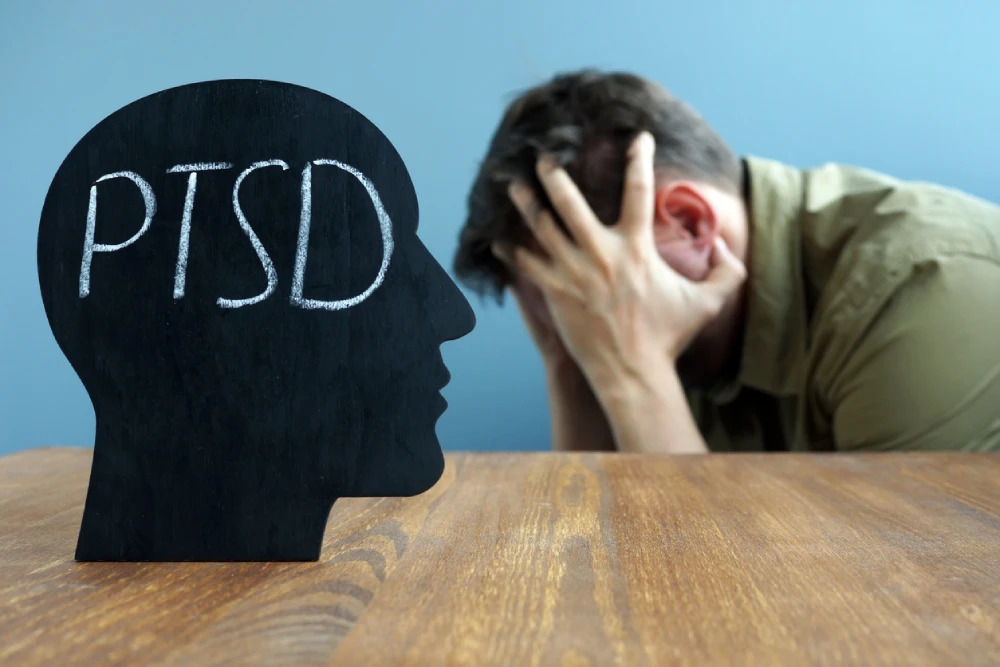Post-Traumatic Stress Disorder (PTSD) is more than just reliving a traumatic experience; it’s a condition that deeply affects a person’s ability to function day-to-day.
Whether rooted in a single traumatic event or prolonged exposure to stress, PTSD can disrupt lives, relationships, and overall well-being.
In Canada, PTSD affects thousands of individuals, from veterans and first responders to those who have experienced personal trauma.
If you or someone you know is dealing with PTSD, understanding the symptoms and available treatments is the first step towards healing.
In this article, we’ll explore the causes, symptoms, and treatments for PTSD, including emerging therapies and self-help strategies.
What is PTSD?
PTSD is a mental health condition that occurs after an individual experiences or witnesses a traumatic event.
This disorder can manifest as intense fear, helplessness, or horror, and it can last long after the event has passed.
PTSD is not just about feeling distressed; it is characterized by persistent symptoms that impair daily functioning.
Prevalence and Impact on Canadians
According to the Government of Canada, approximately 8% of Canadians experience moderate to severe PTSD symptoms, and 5% have a formal PTSD diagnosis. Furthermore, PTSD is more common among women than men.
Those most affected include military veterans, first responders, survivors of abuse, and individuals who have witnessed violence or accidents. However, PTSD can develop from various life events, making it crucial to recognize symptoms early and seek intervention.
Recognizing PTSD symptoms early can significantly improve treatment outcomes. Many individuals live with undiagnosed PTSD for years, often worsening their mental and physical health.
Prompt diagnosis and intervention can help mitigate the long-term impacts of trauma and support a path toward recovery.
What Causes PTSD? 3 Common Factors
PTSD does not stem from a single source; it is often the result of complex interactions between trauma, biology, and environmental factors.
Understanding the root causes can help in managing symptoms and planning effective treatments.
Let’s explore three of the most common causes of PTSD.
Exposure to Traumatic Events
Trauma is the primary cause of PTSD. Traumatic events may include:
- Accidents: Car crashes, workplace injuries, or severe falls.
- Assaults: Physical or sexual violence can leave lasting psychological scars.
- Disasters: Natural catastrophes like floods, fires, or hurricanes.
- Combat: Military personnel often experience PTSD after witnessing or participating in armed conflict.
Chronic Trauma
Some individuals experience ongoing or repeated trauma, which can significantly impact mental health. Chronic trauma often involves:
- Abuse: Physical, emotional, or sexual abuse, especially during childhood.
- Neglect: Long-term lack of emotional or physical support.
- Prolonged Stress: Living in a high-stress environment without relief.
Risk Factors
While anyone exposed to trauma can develop PTSD, certain factors increase vulnerability:
- Genetics: A family history of mental illness may heighten vulnerability.
- Previous Mental Health Conditions: Depression or anxiety can compound PTSD risk.
- Lack of Support: Absence of a support network can make coping significantly harder.

Recognizing PTSD Symptoms – 4 Types
PTSD manifests in various ways, and symptoms can differ significantly from one person to another.
According to the Canadian Psychological Association, PTSD symptoms fall into four categories: Intrusions (re-experiencing), avoidance, negative thoughts, and hyperarousal or reactivity.
1. Intrusions: Re-experiencing or Reliving Trauma
This symptom category involves involuntary reliving of the traumatic event. It includes:
- Flashbacks: Vivid, intrusive memories that feel as if the event is happening again.
- Nightmares: Disturbing dreams related to the trauma, often causing sleep disturbances.
2. Persistent Avoidance Behaviours
To minimize distress, individuals may:
- Steer Clear of Reminders: Avoiding people, places, or activities that recall the trauma.
- Suppress Thoughts: Deliberately trying not to think about the traumatic event.
- Emotional Numbing: Feeling detached from loved ones or daily activities.
3. Negative Thinking
Trauma can alter how a person views themselves and the world, leading to:
- Feelings of Guilt or Shame: Believing they are at fault for what happened.
- Hopelessness: Difficulty imagining a positive future.
- Diminished Interest: Loss of pleasure in previously enjoyed activities.
4. Hyperarousal (Reactivity)
Some may feel perpetually on edge, leading to:
- Irritability or Anger: Easily provoked or frustrated.
- Hypervigilance: Being constantly alert to potential danger.
- Sleep Difficulties: Trouble falling or staying asleep.
Complex PTSD – When Trauma is Prolonged
The Canadian Mental Health Association explains that complex PTSD (C-PTSD) is a form of PTSD that develops after prolonged or repeated trauma, such as ongoing abuse or neglect. Unlike standard PTSD, complex PTSD often includes symptoms of:
- Emotional Regulation Issues: Difficulty controlling intense emotions like anger or sadness.
- Identity Disturbance: Feeling disconnected from one’s sense of self.
- Relationship Problems: Difficulty maintaining healthy interpersonal connections.
Recognizing complex PTSD is crucial as it may require more specialized therapeutic approaches.
Diagnosing PTSD – The Path to Healing
Diagnosing PTSD is not a straightforward process. It involves a comprehensive assessment conducted by healthcare professionals, including psychiatrists, psychologists, or primary care physicians with mental health expertise.
Early diagnosis is critical to managing symptoms effectively and preventing long-term complications. The diagnostic process typically includes understanding the patient’s history, evaluating symptoms, and using standardized screening tools.
Healthcare professionals follow criteria outlined in the Diagnostic and Statistical Manual of Mental Disorders (DSM-5) to identify PTSD. The diagnosis generally requires that symptoms persist for more than a month and cause significant distress or impairment in social, occupational, or other critical areas of functioning.
Assessment Tools and Screenings
Healthcare providers use various validated tools to evaluate PTSD, including:
- Clinician-Administered PTSD Scale (CAPS): A structured interview to assess PTSD symptoms.
- PTSD Checklist (PCL-5): A self-report measure aligning with DSM-5 criteria.
- Impact of Event Scale (IES-R): Evaluates distress caused by traumatic events.
- Primary Care PTSD Screen (PC-PTSD-5): A brief screening tool used in primary care settings.
Role of Healthcare Professionals in Diagnosis
Mental health professionals play a crucial role in diagnosing and guiding treatment. They assess symptoms in the context of the patient’s life, including cultural and social factors that may influence the presentation of PTSD.
Early intervention can significantly reduce symptom severity and enhance recovery prospects.

Effective PTSD Treatments
Treating PTSD often requires a multifaceted approach, combining psychotherapy, medications, and emerging therapies.
The choice of treatment depends on the nature of the trauma, the duration of symptoms, and the individual’s overall mental health.
Treatment plans are typically tailored to meet the specific needs of the patient, emphasizing both symptom management and long-term recovery.
Psychotherapy Options
Psychotherapy is the cornerstone of PTSD treatment. It helps individuals process trauma, develop coping mechanisms, and regain a sense of control. According to the Centre for Addictions and Mental Health (CAMH), some common psychotherapy options include:
- Cognitive Behavioural Therapy (CBT): Focuses on identifying and changing negative thought patterns. Techniques like cognitive restructuring and exposure therapy help patients face traumatic memories in a safe environment.
- Eye Movement Desensitization and Reprocessing (EMDR): Involves guided eye movements to help reprocess traumatic memories, reducing their emotional impact.
- Dialectical Behaviour Therapy (DBT): Especially helpful for those with complex PTSD, DBT combines cognitive and behavioural strategies to improve emotional regulation.
- Sensorimotor Psychotherapy: Integrates physical awareness into the therapeutic process, addressing how trauma is stored in the body.
Medications for PTSD
Pharmacotherapy can complement psychotherapy by managing symptoms like depression, anxiety, and insomnia. The most commonly prescribed medications include:
- Selective Serotonin Reuptake Inhibitors (SSRIs): Such as sertraline and paroxetine, approved for PTSD treatment.
- Serotonin-Norepinephrine Reuptake Inhibitors (SNRIs): Like venlafaxine, effective in reducing anxiety and depressive symptoms.
- Prazosin: Commonly used to manage PTSD-related nightmares and improve sleep.
Emerging Treatments
Innovative therapies are expanding the options for PTSD treatment:
- Virtual Reality Therapy: Simulates traumatic events in a controlled environment to desensitize patients.
- MDMA-Assisted Therapy: Used in clinical trials to enhance the therapeutic process.
- Neurofeedback: Trains patients to regulate brain activity associated with trauma responses.
Combining traditional and emerging treatments often yields the best outcomes, as tailored approaches address both the psychological and physiological impacts of PTSD.
PTSD Self-Help Strategies and Coping Mechanisms
While professional treatment is essential, self-help strategies can significantly support recovery.
Empowering individuals to take proactive steps in managing their symptoms fosters resilience and long-term well-being. Implementing daily routines that prioritize mental health can make a meaningful difference in managing PTSD.
Mindfulness and Relaxation Techniques
Practicing mindfulness helps ground individuals in the present moment, reducing anxiety and intrusive thoughts. Techniques include:
- Meditation: Guided meditation apps can help focus on breathing and relaxation.
- Progressive Muscle Relaxation: Tension release through focused muscle groups.
- Deep Breathing Exercises: Reduces stress and helps regulate the nervous system.
Physical Activity and Healthy Lifestyle Choices
Physical well-being has a profound effect on mental health. Regular exercise can alleviate symptoms by promoting the release of endorphins and reducing tension.
- Exercise Routines: Activities like jogging, yoga, or swimming enhance mood.
- Balanced Nutrition: A diet rich in omega-3s and antioxidants can support brain health.
- Adequate Sleep: Establishing a consistent sleep schedule aids in recovery.
Building a Support Network
Connection with others can provide emotional stability and reduce feelings of isolation.
- Peer Support Groups: Sharing experiences with others who understand PTSD.
- Family Involvement: Educating loved ones about PTSD can foster understanding.
- Community Resources: Local organizations and online forums offer practical advice and support.
Therapy (Individual and Group)
Participation in therapy is crucial for addressing trauma. Group therapy allows for shared healing, while individual sessions provide personalized care. Combining both can offer comprehensive support.
The Role of Pharmacists in PTSD Management
Pharmacists play a vital role in supporting individuals dealing with PTSD, especially when it comes to medication management and providing reliable information.
As accessible healthcare professionals, pharmacists can help patients understand their treatment options, manage side effects, and connect with mental health resources.
This supportive role is crucial, as consistent guidance and medication adherence significantly impact recovery outcomes.
Medication Counselling and Management
Managing PTSD often involves a combination of medications, and pharmacists ensure patients use them correctly. Key support includes:
- Medication Adherence Support: Educating patients on the importance of consistent medication use.
- Side Effect Monitoring: Identifying and addressing adverse reactions, such as sleep disturbances or gastrointestinal issues from SSRIs.
- Drug Interaction Checks: Ensuring that new prescriptions do not negatively interact with existing medications.
- Dosage Adjustments: Collaborating with healthcare providers to optimize medication plans.
Providing Information on Therapy Options
Pharmacists are also well-positioned to offer insights into non-pharmacological treatments. They may:
- Educate on Psychotherapy Options: Highlighting the benefits of CBT, EMDR, or DBT.
- Explain Self-Help Techniques: Offering resources on mindfulness, relaxation, and physical activity.
- Advise on Support Groups: Providing information on local or online peer support communities.
- Distributing Educational Materials: Providing brochures or leaflets on PTSD management.
- Encouraging Professional Help: Gently guiding patients to seek therapy when symptoms persist.

Supporting Loved Ones with PTSD
Living with or caring for someone with PTSD can be challenging. Loved ones may struggle to understand the condition or know how to provide effective support.
Educating family members and friends about PTSD can make a significant difference in the recovery journey. Compassionate and informed support helps reduce isolation and fosters a positive healing environment.
Understanding and Patience
A compassionate approach can alleviate stress for both the individual and their support network. Effective strategies include:
- Learning About PTSD: Understanding the symptoms and triggers to avoid unintentional harm.
- Remaining Patient: Allowing the person to open up when they feel ready without pressure.
- Validating Feelings: Acknowledging their experiences without judgment.
Communicating Supportively
Open communication is key to maintaining trust and providing reassurance. Practical tips include:
- Asking What Helps: Allowing the person to guide how they prefer to be supported.
- Listening Without Interrupting: Giving them the space to express feelings.
- Encouraging Therapy: Gently suggesting professional support without imposing.
Recognizing Signs of Crisis
Knowing when to seek professional help is crucial, particularly if the person shows signs of self-harm or severe depression. Steps to take include:
- Staying Present: Offering calm reassurance and remaining by their side during distress.
- Involving Professionals: If the person poses a risk to themselves or others, contacting emergency services is vital.
Taking the First Step Towards Recovery
PTSD can significantly impact quality of life, but recovery is possible with the right approach. Understanding the symptoms, seeking professional help, and building a support network are essential steps toward healing.
Whether through psychotherapy, medication, or self-help strategies, every effort counts in reclaiming control from trauma.
As a community, we can support those affected by PTSD by fostering awareness, encouraging open conversations, and reducing stigma. PharmaChoice pharmacies are committed to supporting mental health and providing resources to help individuals navigate their wellness journey.
Talk to your local PharmaChoice pharmacist today to get trusted advice and support on managing PTSD and improving your mental wellness.



